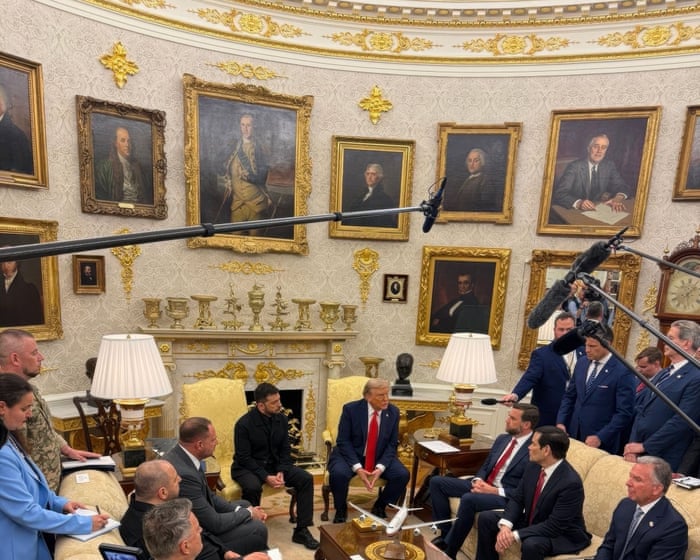In just seven remarkable months, Donald Trump’s administration has made an unprecedented impact on the United States. From reshaping trade policies to challenging legal and scientific conventions, his influence has reached every part of the nation—even the Oval Office itself.
Drawing on his background as a real estate developer and hotelier, Trump has added what he calls his “Trump touches” to the room’s decor. The changes have divided opinion: some see the redesigned office as a symbol of a new American golden age, while others have likened it to a professional wrestler’s dressing room.
During a March tour of the Oval Office, Trump explained to a Fox News host that he felt the room needed “a little life.” He also noted the challenge of making gold paint look convincingly like real gold.
That didn’t stop him from continuing the renovations. In the following months, gold trim appeared on the ceiling, door frames, and fireplace. Even the carved cherubs inside the doorways were painted gold.
Over time, the number of gold trophies and vases on the mantelpiece grew, and gold coasters bearing Trump’s name were added. A White House spokesperson told Fox News that all the gold—described as “of the highest quality”—was paid for personally by Trump.
The president also increased the number of paintings on display, with nearly 20 portraits of former presidents now on the walls. By comparison, Joe Biden displayed just six, and Barack Obama had pictures of only two.
The office also features photos of the Trump family, a copy of the Declaration of Independence, and gifts from visitors—including the FIFA Club World Cup trophy, presented to Trump by the organization’s president.
White House aides have stated that every addition was made at the president’s direction. To assist with the project, Trump reportedly enlisted the help of his personal “gold guy.”
John Icart, a 70-year-old cabinet maker from Florida, was flown to Washington on Air Force One to apply the same decorative touches he had used at Trump’s Mar-a-Lago estate. White House press secretary Karoline Leavitt praised the results, calling it a “golden office for the golden age.”
Not everyone was impressed. Musician Jack White criticized the design as “vulgar” and “gaudy,” comparing it to a wrestler’s dressing room. Reporter Jon Keegan also noted that decorative medallions on the walls closely resembled inexpensive foam accessories sold for about $1 each on Alibaba.
The gold items on the mantel, however, come from the White House’s own collection and include a 19th-century piece, giving them a more distinguished background.A gilded French compotier, urns presented to President James Monroe, and silver from the Eisenhower era are among the furnishings. Trump’s design taste is reportedly influenced by the Hall of Mirrors at Versailles, and he has previously boasted that the ballroom in his Florida residence was modeled after the French palace.
By redecorating the Oval Office, Trump continues a long-standing tradition in which each White House occupant personalizes the space with new furniture, wallpaper, and rugs. Yet few presidents have gone to such lengths to bring the style of their private homes to Washington.
In 2010, the Oval Office had a relatively understated look, featuring a carpet prized by Barack Obama. During the final year of his presidency, when asked which item in the office held the most meaning for him, Obama pointed to that rug. Handcrafted in a Michigan studio, the nearly 10-meter-wide carpet was edged with quotes from American leaders like Abraham Lincoln, John F. Kennedy, and Theodore Roosevelt.
Obama was said to be especially fond of a line from Martin Luther King Jr.: “The arc of the moral universe is long, but it bends toward justice.”
Just months later, as Trump moved into the White House and the nation’s narrative took another surprising turn, Obama’s cherished carpet was removed and replaced with one bearing a golden hue.
Frequently Asked Questions
Of course Here is a list of FAQs about the topic designed to be clear and conversational
Before and After Trumps Oval Office Makeover FAQs
Q What exactly did Trump change in the Oval Office
A He made several changes but the most famous was replacing the traditional creamcolored patterned Clintonera rug with a much brighter solid goldyellow one He also changed the drapes to match and added goldtrimmed upholstery to some chairs
Q Why did he choose the color gold
A The color gold is often associated with luxury wealth and opulence The Trump administration stated the new design was meant to look more regal and project a sense of strength and grandeur
Q Was everything changed What stayed the same
A No many iconic elements remained The Resolute Desk the two flags behind it the presidential seal in the rug and the classic white mantelpiece were all kept in place
Q How much did the makeover cost
A The exact cost to taxpayers is not fully public The redesign was funded by private donations to the White House Historical Association not directly by presidential or campaign funds
Q Did people like the new look
A It was very divisive Some praised it as bold and luxurious while many critics called it gaudy overly flashy and a stark departure from the more understated traditional elegance of previous designs
Q What did the Oval Office look like before
A Before Trump the office under Presidents Obama and Bush had a more muted color scheme It featured a tan and light blue rug with historical quotes woven into it and darker more traditional drapes
Q Who pays for redecorating the Oval Office
A Traditionally redecoration is paid for through private donations to the White House Historical Association or by a White House redecoration fund not by the sitting president personally This is a standard practice to preserve the buildings heritage
Q Do presidents always change the Oval Office decor




